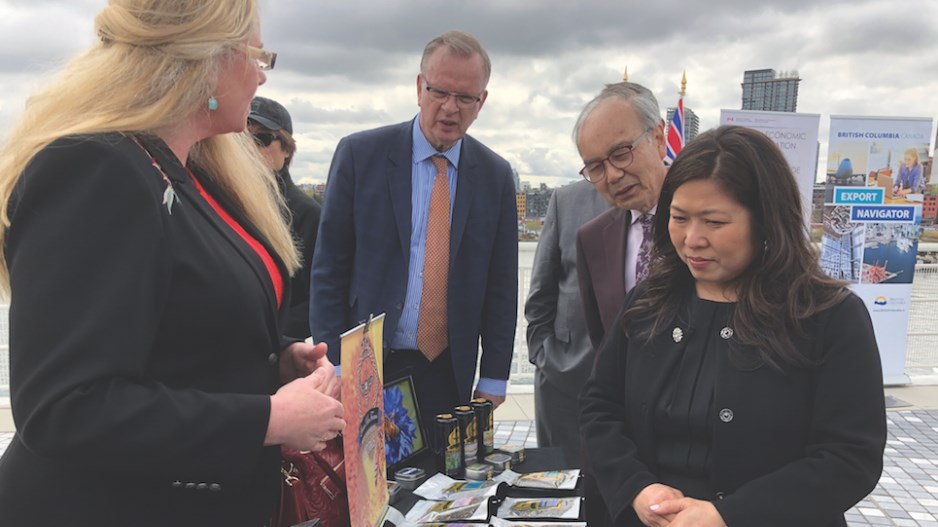With the difficulties Canadian companies are facing on the U.S. and Chinese export fronts, Ottawa is investing a combined $3.75 million in small and medium-sized enterprises (SMEs) in B.C. to push trade with other global markets.
The announcement came in late April as federal Small Business and Export Promotion Minister Mary Ng visited Vancouver to commit $1.5 million to the Trade Accelerator Program at World Trade Centre Vancouver and $2.25 million over three years for the province’s Export Navigator initiative.
Ottawa’s Export Navigator funding comes in conjunction with a new round of commitments from B.C.’s provincial government of $2 million over the next two years. The province is a major supporter of the Trade Accelerator Program, with its $2.5 million partnership with the World Trade Centre playing a key role in the agency delivering the program since 2017.
“The great thing about the announcement is that … the federal government, through Western Economic Diversification Canada, is now a partner,” said B.C. Jobs, Trade and Technology Minister Bruce Ralston. “So it’s an all-hands-on-deck kind of situation…. Really, I don’t think businesses particularly care if the services are delivered provincially or federally; what they want is good services that help them achieve their goals, and that’s the objective.”
The Trade Accelerator Program, which for a fee supports planning and mentorship initiatives to help SMEs grow through exports, will also be supported by the Greater Vancouver Board of Trade.
Officials say the initiative has already helped 140 companies reach markets like Great Britain, the Philippines and Hong Kong in the last year, and the additional funding will continue efforts to provide services.
Meanwhile, the Export Navigator, a free program providing one-on-one export counselling for rural-area entrepreneurs and small businesses, becomes a full-fledged regular government program with April’s funding announcement.
The initiative had been a two-year pilot project. Officials added that this round of funds will mainly go toward resources to help businesses owned by women, youth and Indigenous Peoples. New advisers will be hired in Vancouver and Kamloops to work with those target demographics.
“I don’t think people in those categories are any different than other business owners,” Ralston said. “It’s just an area of special focus because sometimes the potential there is being ignored…. B.C. is relatively small at five million people. Canada is relatively small in the global sense with 37 million people. So to get out into the global market, particularly in niche markets, it’s a revelation for people how successful they can be.”
Ng said the Export Navigator program has already helped 317 companies in B.C., and Ottawa wanted to see those efforts continue, especially given that only about 12% of Canadian small businesses are exporters.
That last figure is something that Ottawa would like to change, given Canada’s 14 free-trade agreements covering markets with a combined population of 1.5 billion, Ng said.
Both provincial and federal officials noted the potential for SMEs to explore niche markets in regions like Japan, South Korea, Southeast Asia and Europe, an understandable focus given the trade difficulties with Canada’s two largest traditional partners looming in the background.
The situation with China is especially dire. After the arrest of Huawei Technologies Co. Ltd. CFO Meng Wanzhou in Vancouver last December, trade relations between Canada and its second-largest trade partner have fallen steadily to new lows, culminating in Chinese officials revoking the export licences of two major Canadian canola producers earlier this year.
Beijing has cited pest issues as the reason for the move, which has now also led to Chinese importers shifting their canola purchases from Canadian producers to those in other markets.
A Statistics Canada report in March noted that canola seeding is now underway, and farmers are expected to seed the fewest acres of canola in three years due to “concerns regarding limited access to China’s canola market.” The report said canola acreage in Canada is expected to drop 6.6% this year to 21.3 million acres, because the remaining stock of canola in storage from 2018 remains high.
In her announcement, Ng noted that a technical team is working with Chinese officials to resolve the issue, but she added there has been no confirmation that Ottawa is sending a higher-level delegation to Beijing to discuss the issue.
“We are working very hard on this,” Ng said. “Let me start with this: We have the best canola in the world. The product we have is an extraordinary product, and we will always stand up for canola farmers and indeed for our businesses in Canada…. [Federal Minister of Agriculture Marie-Claude Bibeau] is working hard with her counterparts in China to be sure that they get to a resolution.”
She said federal officials are also “working hard” to ensure other sectors with exposure to China, such as the tourism industry, maintain the business momentum they had prior to the Huawei arrest late last year. •




